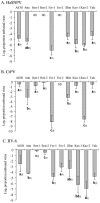Differential adsorption of occluded and nonoccluded insect-pathogenic viruses to soil-forming minerals
- PMID: 16820456
- PMCID: PMC1489329
- DOI: 10.1128/AEM.00254-06
Differential adsorption of occluded and nonoccluded insect-pathogenic viruses to soil-forming minerals
Abstract
Soil represents the principal environmental reservoir of many insect-pathogenic viruses. We compared the adsorption and infectivity of one occluded and two nonoccluded viruses, Helicoverpa armigera single nucleopolyhedrovirus (HaSNPV) (Baculoviridae), Cricket paralysis virus (CrPV) (Dicistroviridae), and Invertebrate iridescent virus 6 (IIV-6) (Iridoviridae), respectively, in mixtures with a selection of soil-forming minerals. The relative infective titers of HaSNPV and CrPV were unchanged or slightly reduced in the presence of different minerals compared to their titers in the absence of the mineral. In contrast, the infective titer of IIV-6 varied according to the mineral being tested. In adsorption studies, over 98% of HaSNPV occlusion bodies were adsorbed by all the minerals, and a particularly high affinity was observed with ferric oxide, attapulgite, and kaolinite. In contrast, the adsorption of CrPV and IIV-6 differed markedly with mineral type, with low affinity to bentonites and high affinity to ferric oxide and kaolinite. We conclude that interactions between soil-forming minerals and insect viruses appear to be most important in nucleopolyhedroviruses, followed by invertebrate iridescent viruses, and least important in CrPV, which may reflect the ecology of these pathogens. Moreover, soils with a high content of iron oxides or kaolinite would likely represent highly effective reservoirs for insect-pathogenic viruses.
Figures

References
-
- Batista-Fihlo, A., S. B. Alves, N. T. Augusto, R. M. Pereira, and L. F. A. Alves. 2001. Stability and persistence of two formulations containing Anticarsia gemmatalis nuclear polyhedrovirus (AgMNPV). Neotrop. Entomol. 30:411-416.
-
- Bitton, G. 1975. Adsorption of viruses onto surfaces in soil and water. Water Res. 9:473-484.
-
- Burand, J. P. 1998. Nudiviruses, p. 69-90. In L. K. Miller and L. A. Ball (ed.), The insect viruses. Plenum, New York, N.Y.
-
- Chattopadhyay, S., and R. W. Puls. 1999. Adsorption of bacteriophages on clay minerals. Environ. Sci. Technol. 33:3609-3614.
-
- Chinchar, V. G., S. Essbauer, J. G. He, A. Hyatt, T. Miyazaki, V. Seligy, and T. Williams. 2005. Iridoviridae, p. 163-175. In C. M. Fauquet, M. A. Mayo, J. Maniloff, U. Desselberger, and L. A. Ball (ed.), Virus taxonomy: VIII report of the International Committee on the Taxonomy of Viruses. Elsevier, London, United Kingdom.
Publication types
MeSH terms
Substances
LinkOut - more resources
Full Text Sources
Medical

